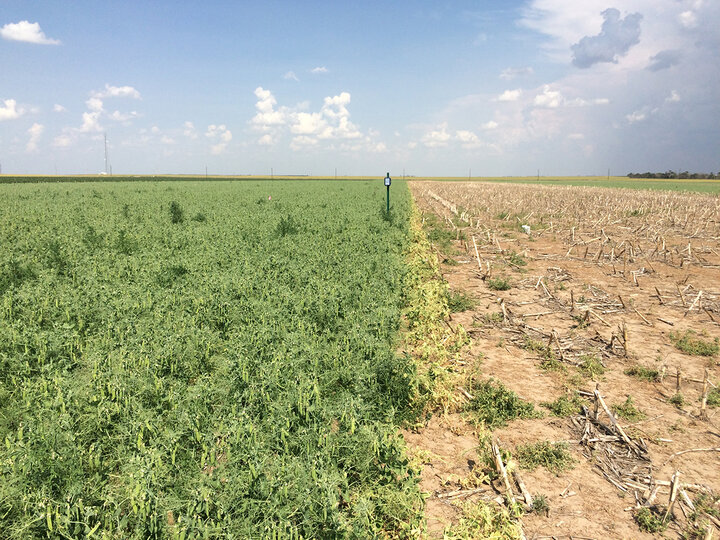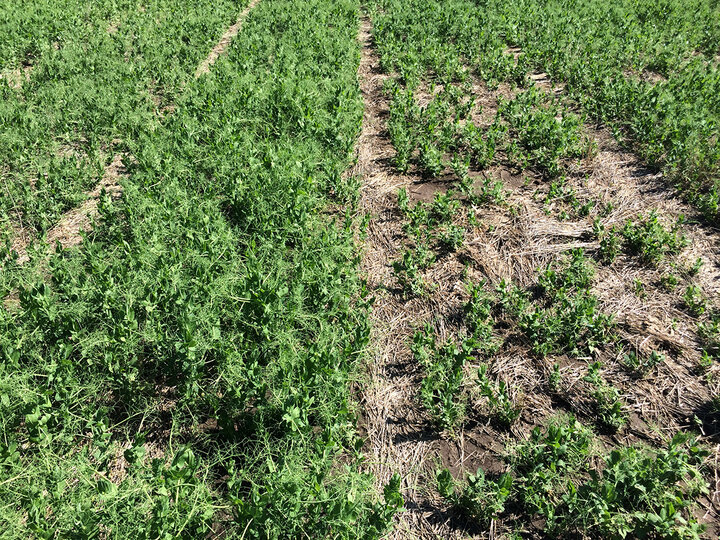Grain-type field pea (Pisum sativum, Figure 1), also known as field peas, yellow dry peas, or yellow peas, is a spring-planted cool-season crop that can be grown as an alternative to summer fallow in semiarid cereal-based cropping systems. The agronomic potential and rotational benefits of field peas have long been observed by dryland farmers in semiarid regions of Colorado, Kansas, Nebraska, and Wyoming. However, lack of market opportunities and locally developed research-based recommendations on agronomic practices have hindered larger adoption of the crop in these regions. As these information gaps are gradually addressed, field pea production is increasing in the western High Plains.
Field Pea Markets
Field pea is an excellent source of highly digestible proteins, making it a valuable ingredient for livestock, pet, and human food products. Most field peas are processed into split peas and exported overseas for human consumption. They are commonly used by the United Nation’s World Food Programme and other food aid initiatives. Research has shown that field pea also may be used as a replacement in hog diets and cattle finishing diets as well as a protein supplement for grazing cattle. In the past 30 years spending on pet food has increased 350% (Figure 2). With this increase, pea fiber and pea protein concentrate (byproducts of pea processing) have become more important ingredients in pet food. In addition, peas have good potential for producing high margin value-added ingredients for use in the health and nutrition sector in the US. The market for sports nutrition shakes and bars is almost $6 billion and growing and the potential for using pea flour as a substitute for wheat is compelling as more people in the US are seeking gluten-free options and reducing their consumption of simple carbohydrates.
Developing Local Markets for Field Peas
In 2016, farmers planted approximately 35,000 acres to field peas in northeast Colorado, northwest Kansas, and southwest Nebraska (estimate based on seed sales) without a guaranteed market. In response Gavilon Goodlife Grains and Pulses created local field pea markets and, it reports, invested in new pea processing and storage facilities in the region. It is now buying field peas in Nebraska, Kansas, Colorado, Wyoming, and South Dakota, offering spot contracts, new crop contracts, storage premium contracts, farm pick up contracts, delivered contracts and acre contracts to field pea growers. Gavilon has five receiving points in Nebraska: Benkelman, Champion/Imperial, Cozad/Lexington, Kearney, and Hastings. In addition to Gavilon, many producers are using on-farm storage and marketing their peas through a number of brokers.
In 2012 there was a similar grower initiative in the Nebraska Panhandle and Stateline Producers Cooperative in Bridgeport and Gering responded by developing local markets and investing in a pea processing facility. Since then, field pea acreage in Nebraska has increased from 10,000 acres to about 100,000 acres, mostly due to larger adoption of field peas in the Nebraska Panhandle.




Researching Field Peas for Long-Term Sustainable Production
Faculty and staff from the University of Nebraska–Lincoln, Kansas State University, and Colorado State University are working closely with farmers and stakeholders to bridge some of the information gaps around growing field peas in semiarid dryland cropping systems. The universities cited are collaborating on research on field pea production in the western High Plains with funding support from their institutions, USDA’s SARE (Sustainable Agriculture Research and Education) program, and the field pea seed industry.
Although we are in the early stages of research and multi-year and multi-location data is yet to be analyzed and published, here are preliminary research findings from UNL’s 2015 rotation study that may help you make informed decisions on replacing fallow with field peas:
- Field peas had higher soil microbial activity than fallow. Thus, release of plant available nitrogen through mineralization of soil organic matter was estimated to be about 20 lb/ac higher than in fallow.
- Field peas had better water utilization than fallow. Field peas produced 36 bu/ac yield using 11 inches of soil water (3.3 bu/acre-inch) and allowed enough time to refill soil water profile with off-season rains to ensure good winter wheat establishment. Fallow used 6 inches of soil water but did not produce anything. It also did not have enough soil water storage to capture the 5.3 inches of additional rain that was leached out below the root zone (4 feet).
- Field peas supported more beneficial insects and microorganisms than fallow.
- Field peas were more profitable than fallow, about $111/ac.
- The trade-offs are that field peas may deplete soil water and potentially reduce yield of the succeeding wheat crop (yield penalty = 5-6 bu/acre-inch), especially in dry years.
- yield and yield quality of the succeeding wheat crop,
- mycorrhizal associations in the succeeding wheat crop,
- system profitability,
- soil water infiltration, and
- soil aggregation (erosion potential).
Research results also are available for
- Multi-year and multi-location field pea yield and variety performance

2016 — International Year of Pulses
The 68th UN General Assembly declared 2016 the International Year of Pulses (IYP) to raise awareness of field peas and other pulse crops (lentils, dry beans, chickpeas) as:
- highly nutritious,
- having important health benefits,
- contributing to climate change mitigation and adaptation,
- promoting biodiversity and sustainable agriculture, and
- being economically accessible and contributing to food security at all levels.
Due to these characteristics, pulses have been called a “superfood of the future” and fundamental to helping end world hunger while protecting the environment.
Results from KSU's fungicide in-furrow fertility and seeding rate studies, as well as UNL’s seeding depth, inoculant, and herbicide studies are yet to be analyzed and published.
Future of Field Peas
Research results will continue to be released at university workshops, field days, and through the media to close the information gap related to producing field peas on the western High Plains. Farmers, consultants, and members of the agriculture industry have attended many of the educational experiences that have been conducted in the region and can expect more releases as information becomes available from this season.
With prices of other crops (wheat, corn, sorghum) fluctuating widely and their cost of production constantly increasing, having an additional, low-input legume crop with stable market can benefit growers, certified seed dealers, field peas processing facilities, and communities in general.

